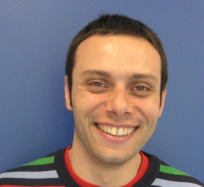Liquid crystalline Hydrogen bonded Rosettes
Promotion date: 3 May 2007
| My thesis is about the synthesis of liquid crystalline materials based on self-assembled molecules. You could compare these molecules with a house with just one room, where you build another one on top, and another and another, until you have a skyscraper. I use the principle of self assembly to get a structure that is actually visible. |
How can you make a molecule that starts to self assemble?
In literature some of the requirements are described. In my case the molecule has a rigid core, like a box, and has filaments attached to it. When they get into contact with each other the filaments form a network. The cores form a column and the filaments become entangled.
One part of the molecule can be found in nature and the other part is purely synthetic.
Than, like a wizard, I put them in a flask and add a bit of solvent and they start to self assemble into a rosette.
They are very beautiful to look at, but surely that is not the reason why you want to make them.
To study the properties of a material, understanding what happens to the material properties if you change a building block for another. Let’s say that we are going toward what is called ‘smart materials’.
I want to know how one single molecule organizes compared to another one and what stimuli should be used. The ultimate aim of course is to build nano or micro devices, using the bottom-up approach.
I have understood that in the bottom up approach a major problem is getting a structure that is big enough for an actual application.
The single molecule has a dimension of three by one nanometers. With proper modelling you can get a structure of micrometer size.
The most important thing of my research is that now we really understand how to produce materials using the principle of self assembly and self organization, changing and modifying the properties since they are not rigid structures.
I understand you had a bit of a difficult start. Why was that?
Our group Supra Molecular Chemical Technology (SMCT) has been working before on these rosettes, but we only looked at the single molecule in a solution. We wanted to go a step further and look at the materials, but nobody in the group had any experience with liquid crystals as such. I started with solutions, but that did not work out and I had to start again.
But once I understood the underlying principle I got going. And I have to thank Mesa+ for that. In the field of self assembly Mesa+ has a worldwide reputation. I also went to Delft and Wageningen University.
How did you come into contact with Mesa?
In Italy there was a professor who knew professor David Reinhoudt. There was a PhD position here in Twente and I wanted to go abroad. I was invited for an interview and liked what was offered.
And did you like it?
Not at the beginning. At the very first day there was some misunderstanding about the key of my apartment which felt like an omen. But after that I really started to like it, this is really one of the best places to be. Everything is so organized.
Any moments of despair?
Phew! Oh yes: I only finished the experiments of the thesis 15 days before the end of my contract. I had a bad time in de third year of my PhD, I really had almost nothing. In the remaining 1,5 year I built up my thesis. But this in my opinion is what doing a PhD is about:
groping in the dark and finding your own way. You have to be determined. It is like putting yourself to the test.
What are you going to do next?
Keep going in the research field, nowadays I’m looking for a job in the south of the Netherlands, because I want rejoin to my girlfriend who is working in a chemical company in Geleen.
For the summary of the thesis, click here

